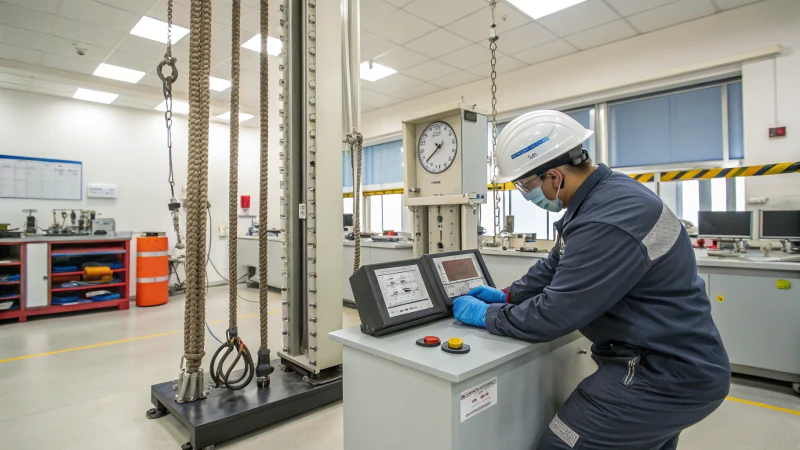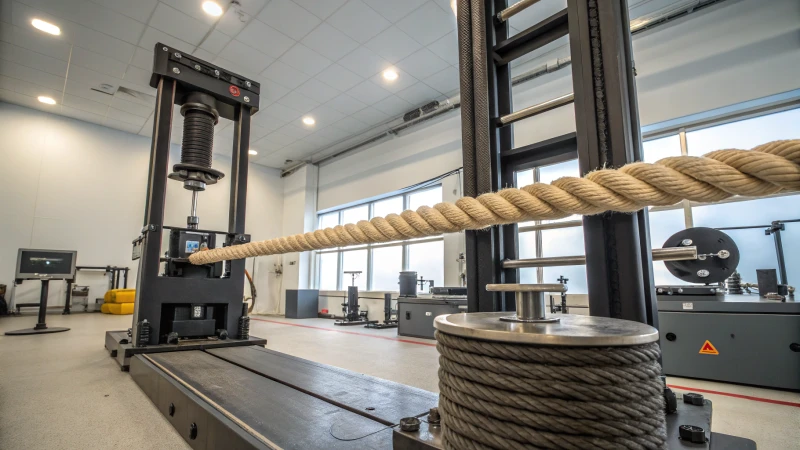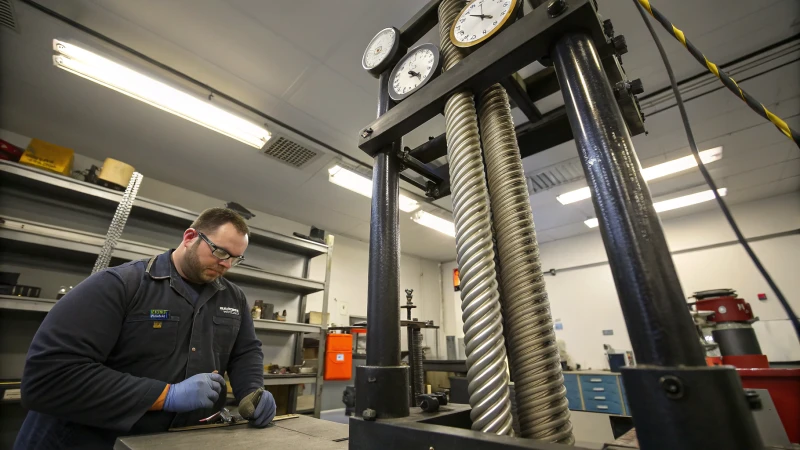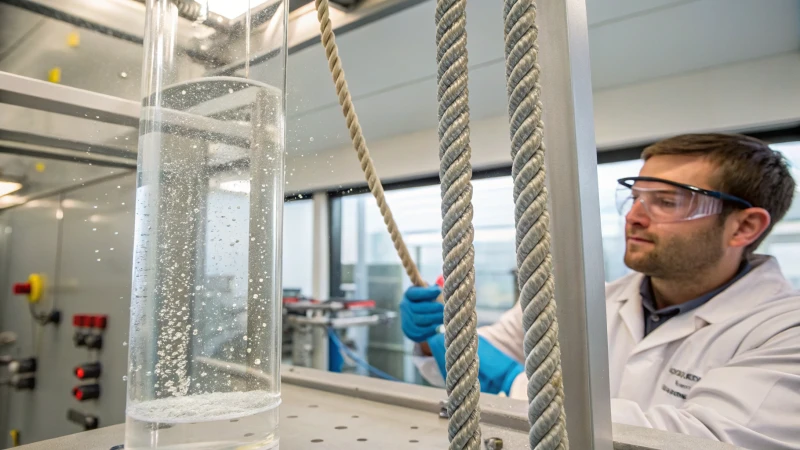
Steel wire ropes are the unsung heroes of many industries, quietly bearing the weight of the world.
The best testing methods for ensuring the quality of steel wire ropes include tensile strength testing, fatigue testing, and corrosion resistance evaluation. These tests help verify that the ropes meet industry standards and are equipped to handle operational stresses safely.
I remember when I first dove into the world of steel wire ropes; it was like uncovering a hidden universe. Understanding how these testing methods—tensile strength, fatigue, and corrosion resistance—work can truly shift how you approach selecting materials. It’s about more than just meeting standards; it’s about knowing your ropes can handle whatever comes their way. Let me walk you through how these tests really make a difference in reliability and safety.
Tensile strength testing is essential for steel rope quality.True
It verifies the rope's ability to withstand high tension without breaking.
Fatigue testing is not necessary for steel wire ropes.False
Fatigue testing assesses the rope's durability under repeated stress cycles.
How Does Tensile Strength Testing Ensure Rope Durability?
Ever wondered how ropes stand up to the immense pressure of heavy loads?
Tensile strength testing is vital for gauging a rope's durability, ensuring it can endure significant tension without breaking. By measuring the force required to stretch a rope to its breaking point, manufacturers confirm its resilience for diverse uses.

What is Tensile Strength Testing?
I remember the first time I witnessed a tensile strength test—it was like watching a tiny rope tug-of-war. Essentially, this test involves applying force to a rope until it finally breaks, revealing just how much stress it can endure. Understanding this breaking point is crucial for manufacturers to ensure their ropes meet safety standards and are fit for various purposes.
Importance of Tensile Strength in Ropes
Think about ropes in your daily life—from securing a hammock to holding up a construction crane. The tensile strength determines the weight a rope can safely support without snapping. I recall a project where steel wire ropes were used in elevator systems; their high tensile strength was non-negotiable to ensure safety and functionality.
| Industry | Application | Required Tensile Strength |
|---|---|---|
| Construction | Crane operations | High |
| Marine | Mooring lines | Medium |
| Rescue Operations | Safety harnesses | High |
Testing Procedures and Standards
Tensile testing adheres to standards like ISO 15630-1, which sets the bar for accurately determining a rope's breaking point. I once marveled at how automated testers with digital analysis software enhance both accuracy and efficiency in these tests.
Advanced Testing Techniques
Innovations in testing don't stop there. From rotary bending machines1 for fatigue analysis to salt spray tests for corrosion resistance, these methods simulate real-world conditions, ensuring ropes are up to the task in any environment.
Benefits of High Tensile Strength Ropes
High tensile strength ropes are like unsung heroes, quietly preventing accidents by maintaining integrity under pressure. This reliability is especially critical in industries like construction2 and marine sectors, where safety cannot be compromised.
When it comes to selecting ropes, professionals like John or Emma rely on tensile strength testing data to make informed choices that meet or exceed safety standards, ensuring everything runs smoothly.
Tensile strength testing prevents rope failures.True
Testing identifies the maximum stress ropes can endure, ensuring safety.
Marine ropes require high tensile strength like crane ropes.False
Marine ropes generally need medium tensile strength, not high like cranes.
Why is fatigue testing crucial for steel wire ropes?
Imagine relying on a rope for safety during a crucial lift—understanding its endurance is vital.
Fatigue testing is essential for evaluating steel wire ropes, as it replicates real-world stresses to identify weaknesses and ensure reliability.

Understanding Fatigue Testing
Fatigue testing involves subjecting steel wire ropes to repeated cycles of stress or strain to mimic real-world conditions. This process helps in determining how these ropes will perform over time when exposed to dynamic loads.
One common method is the rotary bending test, which continuously bends the rope over a pulley to simulate operational wear. I remember once being fascinated by how a machine could bend a rope repeatedly, mimicking the wear and tear it would face in real life.
Importance in Safety and Reliability
For industries relying on steel wire ropes, such as construction3 and mining, fatigue testing is essential for ensuring safety and performance. I once had a close call with a rope failure that could have been avoided with better fatigue testing. Such experiences underscore the importance of identifying potential failures that static tests might miss.
By identifying weak points, companies can make informed decisions on rope replacement and maintenance schedules, avoiding unforeseen mishaps.
Methods and Equipment Used
Rotary Bending Machines
These machines simulate operational conditions by subjecting ropes to constant bending cycles. The number of cycles a rope withstands before failure indicates its fatigue resistance. I recall watching one such test and being amazed at the data it provided about the rope's lifecycle.
| Method | Description |
|---|---|
| Rotary Bending | Simulates bending over pulleys |
| Axial Fatigue | Tests tension cycles |
| Torsional Fatigue | Assesses twisting under load |
Digital Analysis Tools
Modern fatigue testing often employs automated systems with digital data analysis, providing real-time insights. This enhances accuracy and efficiency, improving decision-making for procurement managers like me when time-sensitive decisions are at stake.
Real-World Applications
In mining operations, tested ropes ensure continuous operation without unexpected failures, which can lead to costly downtimes or accidents. I recall a project where downtime was slashed because we used ropes that had undergone rigorous fatigue testing. The peace of mind knowing that every lift was secure was priceless.
Similarly, construction projects benefit from using ropes that have been rigorously tested for fatigue, ensuring they can withstand the stresses of heavy lifting without compromising safety standards. Understanding the results from fatigue testing allows stakeholders to select ropes that best meet their specific operational needs, leading to improved project outcomes and reduced risks. Durability4 is not just a word—it's what drives decisions for procurement managers like me when choosing steel wire ropes.
Fatigue testing predicts steel rope lifespan.True
Fatigue testing assesses endurance under cyclic loads, predicting lifespan.
Rotary bending tests simulate static loads.False
Rotary bending tests simulate dynamic, not static, operational conditions.
How Is Corrosion Resistance Tested in Steel Wire Ropes?
Imagine standing on a construction site, feeling the weight of safety on your shoulders, knowing that every choice you make about materials could impact the lives of your team.
Corrosion resistance in steel wire ropes is tested using methods like salt spray testing, immersion tests, and electrochemical evaluations. These tests simulate harsh environments to assess durability against corrosion, ensuring the ropes can withstand the elements over time.

Salt Spray Testing
I remember the first time I learned about salt spray testing, and it felt like a revelation. Picture this: ropes enduring a relentless saline mist, much like the harsh conditions they face at sea. It's as if they're put through a mini ocean storm inside a chamber. This method not only tests their mettle but also gives us crucial insights into how they might perform over years of exposure. Salt spray chambers5 are fascinating to watch in action.
Immersion Testing
Immersion testing takes me back to those science experiments in school, but on a grander scale. Imagine dunking ropes into all kinds of corrosive solutions, from mild to extreme, and watching how they hold up. It's like taking them on a journey through different environments, each with its own story to tell. The variety in solutions and durations helps us understand how well coatings protect the ropes, ensuring they can face real-world challenges head-on. Immersion testing standards6 are our guideposts in this journey.
Electrochemical Evaluation
I find electrochemical evaluations particularly intriguing—it's like giving ropes an electrifying health check. By applying electrical currents and observing responses, we can predict how long they'll last under various conditions. It's like peering into the future of a rope's life, understanding parameters that are crucial when high corrosion resistance is a must. With electrochemical analysis7, engineers have a crystal ball that helps them choose the right materials for the right projects.
Comparative Analysis with Other Materials
Choosing between steel wire ropes and other materials can feel like being in a showroom full of options, each with its own flair and function. A comparative analysis paints a clear picture of what each material brings to the table:
| Material | Corrosion Resistance | Strength | Durability |
|---|---|---|---|
| Steel Wire Rope | Moderate to High | High | High |
| Synthetic Rope | Low | Medium | Medium |
| Coated Cable | High | Medium | High |
It's all about matching the right rope to the right job, ensuring longevity and safety. Material comparison guides8 help procurement managers like me make informed decisions.
Steel wire ropes are my go-to for construction and mining projects where strength and reliability are non-negotiable. Understanding corrosion testing isn't just about ticking boxes; it's about ensuring that what holds everything together can weather whatever comes its way. For construction managers9 like myself, it's vital for ensuring safety and performance under tough conditions.
Salt spray testing simulates marine environments.True
Salt spray testing uses saline mist to mimic sea conditions for steel ropes.
Synthetic ropes have high corrosion resistance.False
Synthetic ropes have low corrosion resistance compared to steel wire ropes.
Why Are Automated Testing Systems Becoming Essential?
I remember the first time I encountered an automated testing system and how it transformed my approach to software development. It felt like discovering a hidden superpower, one that could save time and reduce errors.
Automated testing systems are essential in today's software development landscape because they significantly boost efficiency, accuracy, and scalability. By minimizing human errors and expediting the testing process, they support continuous integration and delivery, ensuring high-quality software outcomes.

The Shift from Manual to Automated Testing
I’ve always thought of manual testing as akin to assembling a puzzle by hand. It’s effective but painstakingly slow and prone to human errors. Automated testing is like having a robot helper who knows exactly where every piece goes, doing the heavy lifting while I focus on the bigger picture. These systems execute predefined test cases with precision, enhancing accuracy and reliability without needing constant oversight.
Benefits of Automated Testing Systems
-
Speed and Efficiency
- Imagine a world where testing happens as you sip your morning coffee. Automated tests run simultaneously and faster than any manual test could, cutting down testing cycles drastically. This speed means issues surface early on, saving future headaches.
-
Consistency and Repeatability
- Automation is like having a reliable friend who never forgets a task. Tests are consistently performed across different environments without the risk of human oversight.
-
Scalability and Coverage
- Remember trying to juggle multiple tasks at once? Automated systems handle this with ease, scaling with your application and covering more ground than manual testing ever could.
Integration with Continuous Delivery
Incorporating automated testing into continuous integration and delivery pipelines is like having a security net that catches flaws before they reach production. Developers get immediate feedback on code changes, which is crucial for maintaining quality across releases. Incorporating these tests into the CI/CD pipeline10 ensures a seamless process where nothing slips through the cracks.
Implementing Automated Testing Systems
Starting with automated testing might seem daunting at first—like learning to ride a bike. But choosing the right tools, designing a robust framework, and keeping scripts maintainable turns the initial wobble into a smooth ride. Many of us lean on open-source tools like Selenium11 for UI tests or JUnit12 for unit tests.
| Feature | Manual Testing | Automated Testing |
|---|---|---|
| Execution Time | Slow | Fast |
| Human Intervention | High | Minimal |
| Scalability | Limited | High |
| Cost Over Time | High | Lower |
Challenges in Automation
Automation isn’t without its bumps. Initial setup can be costly, maintaining test scripts needs patience, and it requires specialized skills—like learning to drive a new car model. However, once set up, the efficiency gains are worth the investment in time and resources.
Understanding these facets helps organizations lay down an effective automated testing strategy, leading to more reliable software releases.
Automated testing reduces human error.True
Automated systems execute tests without human intervention, minimizing errors.
Manual testing is faster than automated testing.False
Automated tests run faster, significantly reducing the time required for testing cycles.
Conclusion
This article discusses essential testing methods for steel wire ropes, including tensile strength, fatigue, and corrosion resistance tests, ensuring safety and reliability in various industrial applications.
-
Learn about rotary bending machines used in fatigue testing to simulate real-world stress on ropes. ↩
-
Discover why high tensile strength is crucial for ropes used in construction applications. ↩
-
Discover how fatigue testing enhances safety and performance in construction applications. ↩
-
Learn why durability is critical for industrial use of steel wire ropes. ↩
-
Discover how salt spray testing evaluates material durability in marine conditions. ↩
-
Learn about standardized immersion testing procedures for accurate corrosion assessments. ↩
-
Explore how electrochemical analysis predicts material lifespan against corrosion. ↩
-
Compare different materials to make informed procurement decisions. ↩
-
Ensure compliance with safety standards for construction applications. ↩
-
Explore how CI/CD pipelines integrate automated testing to streamline software development workflows. ↩
-
Discover how Selenium automates web application testing across various browsers. ↩
-
Learn how JUnit facilitates automated unit testing in Java applications. ↩

